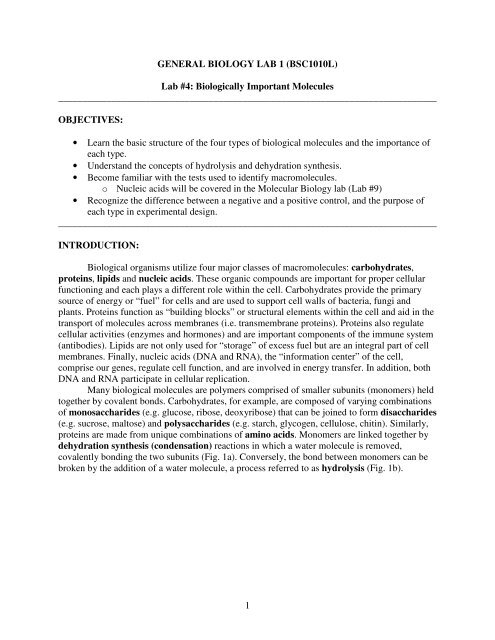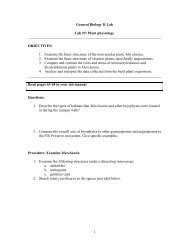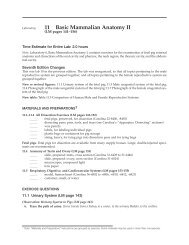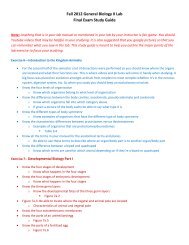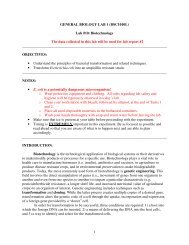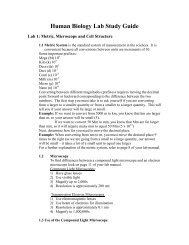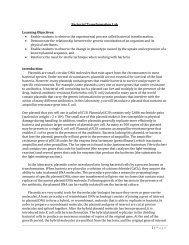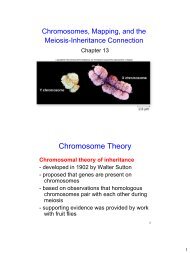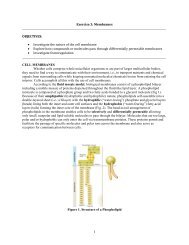1 GENERAL BIOLOGY LAB 1 (BSC1010L) Lab #4: Biologically ...
1 GENERAL BIOLOGY LAB 1 (BSC1010L) Lab #4: Biologically ...
1 GENERAL BIOLOGY LAB 1 (BSC1010L) Lab #4: Biologically ...
You also want an ePaper? Increase the reach of your titles
YUMPU automatically turns print PDFs into web optimized ePapers that Google loves.
<strong>GENERAL</strong> <strong>BIOLOGY</strong> <strong>LAB</strong> 1 (<strong>BSC1010L</strong>)<strong>Lab</strong> <strong>#4</strong>: <strong>Biologically</strong> Important Molecules______________________________________________________________________________OBJECTIVES:• Learn the basic structure of the four types of biological molecules and the importance ofeach type.• Understand the concepts of hydrolysis and dehydration synthesis.• Become familiar with the tests used to identify macromolecules.o Nucleic acids will be covered in the Molecular Biology lab (<strong>Lab</strong> #9)• Recognize the difference between a negative and a positive control, and the purpose ofeach type in experimental design.______________________________________________________________________________INTRODUCTION:Biological organisms utilize four major classes of macromolecules: carbohydrates,proteins, lipids and nucleic acids. These organic compounds are important for proper cellularfunctioning and each plays a different role within the cell. Carbohydrates provide the primarysource of energy or “fuel” for cells and are used to support cell walls of bacteria, fungi andplants. Proteins function as “building blocks” or structural elements within the cell and aid in thetransport of molecules across membranes (i.e. transmembrane proteins). Proteins also regulatecellular activities (enzymes and hormones) and are important components of the immune system(antibodies). Lipids are not only used for “storage” of excess fuel but are an integral part of cellmembranes. Finally, nucleic acids (DNA and RNA), the “information center” of the cell,comprise our genes, regulate cell function, and are involved in energy transfer. In addition, bothDNA and RNA participate in cellular replication.Many biological molecules are polymers comprised of smaller subunits (monomers) heldtogether by covalent bonds. Carbohydrates, for example, are composed of varying combinationsof monosaccharides (e.g. glucose, ribose, deoxyribose) that can be joined to form disaccharides(e.g. sucrose, maltose) and polysaccharides (e.g. starch, glycogen, cellulose, chitin). Similarly,proteins are made from unique combinations of amino acids. Monomers are linked together bydehydration synthesis (condensation) reactions in which a water molecule is removed,covalently bonding the two subunits (Fig. 1a). Conversely, the bond between monomers can bebroken by the addition of a water molecule, a process referred to as hydrolysis (Fig. 1b).1
Figure 1. Dehydration synthesis and hydrolysis reactionsAlthough all macromolecules are characterized by the presence of a carbon backbone, thefour classes vary in their elemental structure and thus, their chemical properties (Fig. 2). Thedisparate functional groups impart different solubilities and polarities to each type ofmacromolecule. For instance, lipids, which are made of fatty acids and have very little oxygen,are nonpolar and insoluble in water (i.e., hydrophobic). Proteins, on the other hand, are polymersof amino acids covalently linked by peptide bonds. Because amino acids are polar, non-polar,charged or aromatic, the properties of the resulting proteins vary in accordance with the type ofamino acids that comprise them.In today’s lab, you will perform a battery of biochemical tests to detect the presence ofdifferent organic molecules in known substances. Throughout this process, you will learn aboutthe use of controls as standards for comparison and their role in identifying unknown solutions.Controls are an essential component of every experiment because they help eliminate alternateexplanations of experimental results. In general, a control is defined as any variable that is keptconstant throughout the entire experiment and is compared to the experimental sample(s) beingtested. There are two types of controls: negative and positive. A negative control helps minimizefalse positives by providing a known negative result for a given experimental treatment. Thus, anegative control provides an example of what the results should look like if the experimentalmanipulation had no effect on the variable of interest. A positive control, on the other hand,helps minimize false negatives by demonstrating what a positive result should look like if the2
experimental manipulation produces a change. For example, when testing for the presence of saltin a substance, a salt solution would serve as the appropriate positive control and distilled wateras the negative control. By applying your knowledge about basic macromolecule structure andusing the proper controls you should be able to identify any unknown compound.Figure 2. Basic structures and functional groups of macromolecules3
Task 1: CARBOHYDRATESCarbohydrates are molecules made of simple sugars with Carbon (C), Hydrogen (H) and Oxygen(O) in a ratio of 1:2:1. Monosaccharides (Fig. 2A) are made of single sugar molecules whiledisaccharides (Fig. 2B) and polysaccharides (Fig. 2C) are composed of two or more sugarmolecules, respectively.ABCFigure 3. Carbohydrate MoleculesMonosaccharides contain either aldehyde (-CHO) or ketone (-C=O) side groups thatreduce oxidizing compounds. A molecule is oxidized if it loses an electron or hydrogen atom andis reduced when it gains an electron or hydrogen atom (Fig. 4). Collectively, the two processesare referred to as a redox reaction because when one molecule is oxidized, another is reduced.Figure 4. Redox reactions4
I. Examine Reducing SugarsBenedict’s reagent can be used to identify the presence of reducing sugars and istherefore a good indicator for the presence of some carbohydrates. At basic/alkaline pHs (8-14)the copper ions (Cu 2+ ) in Benedict’s reagent are reduced by the monosaccharide functionalgroups (i.e. -CHO or –C=O) to form cuprous oxide. In the Benedict’s test for reducing sugars,the Benedict’s reagent is reduced while the reducing sugar is oxidized. This redox reactionresults in a tractable color change going from a light blue solution to a green/reddish orangeone. The intensity of the color change is indicative of the amount of reducing sugar present (Fig.5).A = negative (no reducing sugarspresent)B = positive (small amount ofreducing sugars present)C = positive (larger amount ofreducing sugars present)D = positive (abundance ofreducing sugars present)Figure 5. Examples of expected test results for positive and negative reactions inBenedict’s test for reducing sugars.Procedure:1. Obtain seven test tubes and number them 1-7.2. Add the materials listed in Table 1 to each of your tubes.3. Half fill a 250mL beaker with water. Place it on the hot plate at your station and allow itto come to a gentle boil.4. In the meantime, predict the color changes you expect to occur in each tube and recordthem in Table 1 in the “Benedict’s Test Results Expected (color)” column. Also markwhich tube you think is the positive control with a * and which is the negative controlwith a **.5
5. Add 2mL of Benedict’s reagent to each tube.6. Place all 7 tubes in the gently boiling water bath for 3 minutes. Observe the tubes for anychange in color during this time.7. After 3 minutes, remove the tubes and allow them to cool to room temperature. Recordthe color of each tube in Table 1 in the “Benedict’s Test Results Observed(color)”column.Table 1:Tube #SolutionBenedict’s Test ResultsExpected(color)Observed(color)Iodine Test ResultsExpected(color)Observed(color)1 10 drops onion juice2 10 drops potato juice3 10 drops sucrose4 10 drops glucose5 10 drops distilled water6 10 drops reducing sugar7 10 drops starchQuestions:a. What is the purpose of using negative and positive controls in the experiment above?6
o Which of the solutions in Table 1 were your positive and negative controls?Explain.b. Was the Benedict’s test able to detect ALL sugars you examined? Explain.II. Examine StarchStarch is a polysaccharide often used by organisms for storage of metabolic energy.Unlike the simpler mono- and disaccharides, starch is a structurally complex polymer (Fig. 6).Iodine (iodine-potassium iodide, I 2 KI) reacts with the three-dimensional (3D) structure of thismolecule, resulting in a color change (going from yellow to blue-black, Fig. 7). In this exercise,we will test the substances previously examined for the presence of reducing sugars for starch.Figure 6. Starch Molecule7
A = negative (no starch present)B = positive (starch present)Figure 7. Examples of expected test results for positive and negative reactions in theIodine test for starch.Procedure:1. Obtain seven test tubes and number them 1-7.2. Add the materials listed in Table 1 to each of your tubes.3. Predict the color changes you expect to occur in each tube and record them in Table 1 inthe “Iodine Test Results Expected (color)” column. Also mark which tube you think isthe positive control with a * and which is the negative control with a **.4. Add 7-10 drops of iodine to each tube.5. Record the color of each tube in Table 1 in the “Iodine Test Results Observed (color)”column.Questions:a. Based on your test results, what is the predominant carbohydrate in onion juice? Whatabout potato juice?b. Which of the solutions in Table 1 were your positive and negative controls for starch?Explain.8
Task 2: PROTEINSProteins are composed of amino acids covalently linked by peptide bonds (Fig. 9). Allamino acids contain an amino group (-NH 2 ), a carboxyl group (-COOH), and a variable sidechain (R-group, Fig. 8) by which they are categorized. Peptide bonds (C-N) form when theamino group of one amino acid reacts with the carboxyl group of another (Fig. 9). The Biuretreagent, regularly colored blue, is used to identify proteins. When the copper ions (Cu 2+) in thereagent interact with peptide bonds, a violet color is produced (Fig. 10). In order for theinteraction between Cu 2+ and the peptide bonds to result in a color change, a minimum of 4-6peptide bonds is required. In general, the longer the protein chain, the greater the intensity of thereaction.Figure 8. Amino Acid StructureFigure 9. Protein composed of two aminoacids and linked by a peptide bond (red).A = negative (no protein containing > 4-6peptide bonds present)B = positive (small amount of proteincontaining > 4-6 peptide bonds present)A B CC = positive (large amount of proteincontaining > 4-6 peptide bonds present)Figure 10. Examples of expected test results for positive and negative reactions for theBiuret test for protein.9
Procedure:1. Obtain 5 test tubes and number them 1-5.2. Add the substances listed in Table 2 to each test tube.3. Predict the color changes you expect to occur in each tube and record them in Table 2 inthe “Expected Results (color)” column. Also mark which tube you think is the positivecontrol with a * and which is the negative control with a **.4. Add 2mL of 2.5% sodium hydroxide followed by 3 drops of Biuret reagent.6. Record the color of each tube in Table 1 in the “Observed Results (color)” column.Table 2:Tube # Solution Expected Results(color)Observed Results(color)1 2mL egg albumen 12 2mL honey3 2mL amino acid solution4 2mL distilled water5 2mL protein solution1 Albumen = clear liquid inside of an egg (“egg white”)Questions:a. Using the Biuret test, what would a positive and a negative result indicate?10
. Hypothetically, you test two different substances for the presence of protein. One testprovides a strong positive result and the other a weak, but still positive result. What doesthis indicate about the two samples?Task 3: LIPIDSLipids, which include triglycerides (fats), steroids, waxes, and oils, vary in function.While triglycerides and oils serve as energy-storage molecules, phospholipids aggregate to formcellular membranes which are important source of cholesterol, a necessary component of steroidhormones. All lipids share one characteristic; they are insoluble in water (i.e. hydrophobic)because they have a high proportion of non-polar carbon-hydrogen bonds and can only dissolvein non-polar solvents such as ether, ethanol and acetone. This property can be used to testunknown solutions for the presence of lipids. One indicator commonly used is Sudan IV, a fatsolubledye that binds to lipids when added to a solution (Fig. 11).I. Examine Lipid SolubilityProcedure:1. Obtain two test tubes and number them 1 and 2.2. In this exercise, you will assess the solubility of lipids in polar and non-polar solvents.Predict what you expect to occur in each tube and record your predictions in Table 3 inthe “Expected Results” column.3. Add 1mL of vegetable oil to each tube followed by the solutions listed in Table 3.4. Record your observations in Table 3 in the “Observed Results” column.11
Table 3:Tube # Solution Expected Results Observed Results1 5mL water2 5mL acetone 11 Molecular formula for acetone: (http://upload.wikimedia.org/wikipedia/commons/1/19/Acetone-structural.png)Questions:Did your results corroborate what you know about a lipid’s structure and solubilityproperties? Explain.II. Sudan IV Test for LipidsProcedure:1. Obtain five test tubes and label them 1-5.2. Add the substances listed in Table 4 to each test tube.3. Predict the color changes you expect to occur in each tube and record them in Table 2 inthe “Expected Result (color)” column. Also mark which tube you think is the positivecontrol with a * and which is the negative control with a **.4. Add 10 drops of water to tube 1 and 10 drops of Sudan IV to the remaining four tubes.5. Carefully cover each tube with parafilm and invert the tubes 2-3 times to mix thecontents.12
5. Record the color of each tube in Table 4 in the “Observed Results (color)” column.Table 4:Tube # Solution Expected Result(color)Observed Result(color)1 1mL salad oil2 1mL salad oil3 1mL honey4 1mL distilled water5 1mL known lipidA = positive (lipids present)B = negative (no lipids present)Figure 11. Examples of expected test results for positive and negativereactions for the Sudan IV test for lipids (http://faculty.cbu.ca/cglogowski/images/Lipid%20test.JPG)13
Questions:a. What was the purpose of tube 1?b. Lipids contain twice as many calories per gram compared to carbohydrates. Based onyour test results, which has more calories, the salad oil or the honey?LOOK AHEAD:• Before coming to lab next week, make sure to read the Enzymes Task sheet as well asExercise 11 in your lab manual.______________________________________________________________________________14


